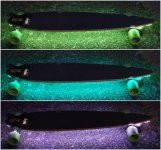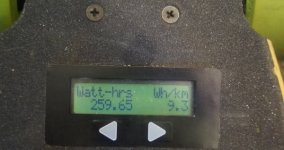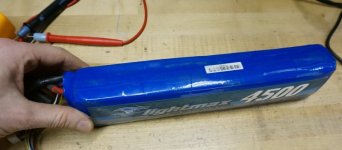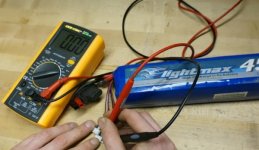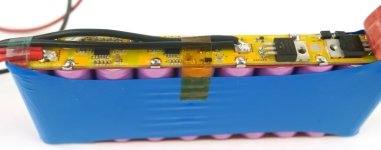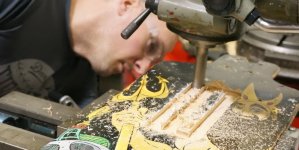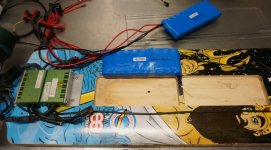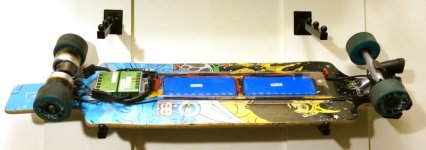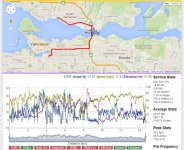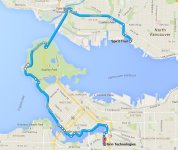Hummina Shadeeba said:
inspirational.
What happened to the more recent skateboard motors you made that were part of a collaboration and were more recessed into the wheel?
I was gonna get to that next. We did an overhaul on both boards and I was really curious to see how the more fully recessed motor was holding up. I was a little concerned that the thin-section motor ball bearings might not be fairing too well. The whole principle of this design approach should be that the shock and impact loads are taken by the skateboard wheel ball bearings, and that the motor ball bearings would be just there to centralize the motor without taking the rider's weight. But since the large wide wheel overlaps the motor a fair amount, any rocks or impact on the insides of the wheels would still transfer to the motor ball bearings.
Anyways this is what it looked like coming apart. There was a lot of powdery black gunk, and it turns out that was the black paint finish from the RC motor shell which had been ground and worn off by the motor slipping inside the wheel. Remember on this build there was no positive indexing between the wheel and the motor, we just slightly undersized the cavity in the wheel so that it was a snug fit on the motor shell, and it doesn't surprise me that in use there would be a little bit of slippage.
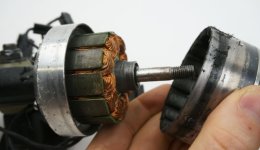
Also some little bits of ferrous material that got picked up from the road and what not. I few blasts with an air compressor cleaned it up pretty well. And the good news is that the thin section ball bearings weren't much worse for wear.
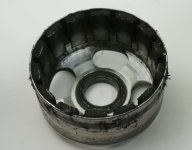
I'm surprised these two are still going being exposed to curbs and flying rocks.
They are a little dinged up, but still going strong for sure. So we'll keep riding them as is until/if anything actually goes.
NOW, months later, seeing how the hub motor is all the rage and it's construction seems less complex, this method of mounting seems an overly complicated way to get pretty much the same thing done, but with more vulnerabilliy.
The downside of having the motor 100% enclosed in the wheel is that you then need a specially molded wheel sleeve that slides over the hub, you can't easily use off-the-shelf interchangeable skate wheels. But with the motor beside the wheel and only partially enclosed by it, then you can replace your wheels and wheel bearings much easier as they wear down. The challenge is then making the motors as thin and pancake like as possible to reduce their exposure.
torqueboards said:
Nice display. What display did you use for that?
Not of the electric bike ilk eh? :wink: That is an old school small screen Cycle Analyst, but with a modern CA V3 circuiboard that has many more has inputs for torque sensors etc. which were repurposed to read the front and back strain gauge signals instead. It's pretty handy having it flush mounted on the deck like that, but I found that the membrane overlay label tended to get peeled up from people's feet so while it was apart last week I worked the recess a bit deeper into the deck so that it would sit below the grip tape.
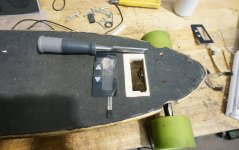
With the deck all stripped down again, it was also a great opportunity to recess all of the other electronics and wiring into the woodwork. So I used a regular router to make channels down the sides for the LED light strips, and then a milling machine to make a pocket under the battery for the driver circuitry, and also channels at the front for half a dozen front facing white LED lights as an integrated headlight
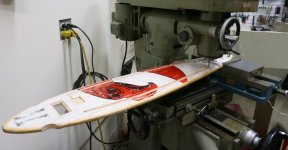
I wanted the lighting system integrated into the deck and 100% rugged, so after milling the channels and wiring everything up it was back-filled with epoxy resin. Later on I plan to rough up the epoxy finish a bit and then continue on the paint job on the deck, masking off just a small dot over each LED emitter. That way the lights will just come out of nowhere.
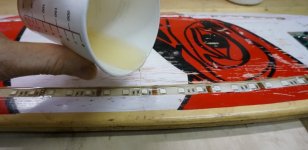
Great work as usual Justin, have you integrated your FOC into this board yet?
These are still the stock FOC controllers from ASI, we don't actually need the power upgraded ones because we're phase limiting the current into each motor to just like 30 amps anyways. The controllers even with stock 10mOhm fets stay pretty cool to the touch, while the motors are decidedly hot after a long trip. But we still have occasional problems due to vibrations with these controllers, especially since it's two PCBs that are connected together via a header/socket arrangement. Next build will definitely be a fully potted controller too in order to make it immune to the rattle.

Pediglide said:
Hooray for hands-free!

I hear you buddy. Sky's the limit for what you then decide to occupy your hands with!
http://www.youtube.com/watch?v=ISKkPyu1Zo4&t=12m25s



